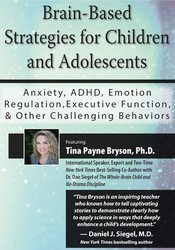Description
Watch Dr. Tina Payne Bryson, international speaker and co-author with Daniel J. Siegel, M.D. of The New York Times bestsellers The Whole-Brain Child and No-Drama Discipline, as she revolutionizes the way you treat behavioral, emotional and somatic challenges using brain-based strategies for children and adolescents.
This workshop will use an interpersonal neurobiology lens to focus on bilateral and vertical brain integration that will challenge your current ways of understanding and treating behavioral and emotional struggles. Using stories, case studies, videos and humor, Tina will provide creative strategies on how to integrate brain science into your practice and personal life. Dive into the neurobiological aspects of attachment and narrative. Learn the latest on neuroplasticity, plus experience the changing brain in a way that’s clear, interesting and practical.
- Acquire new tools to help children and families with:
- Anxiety
- ADHD
- Attachment
- Behavioral avoidance
You will walk away with a new framework for treating children, adolescents and families along with effective strategies to improve attention, emotional regulation and resilient flexibility!
CPD
CPD
- PESI Australia, in collaboration with PESI in the USA, offers quality online continuing professional development events from the leaders in the field at a standard recognized by professional associations including psychology, social work, occupational therapy, alcohol and drug professionals, counselling and psychotherapy. On completion of the training, a Professional Development Certificate is issued after the individual has answered and submitted a quiz and course evaluation. This online program is worth 6.0 hours CPD for points calculation by your association.
Faculty
Parenting consultant and psychotherapist
Private Practice
Tina Payne Bryson, Ph.D., is the co-author (with Dan Siegel) of two New York Times bestsellers, The Whole-Brain Child (Bantam, 2012) and No-Drama Discipline (Bantam, 2016), as well as The Yes Brain (Bantam, 2019). Dr. Bryson is also the co-author (with Dan Siegel, M.D.) of The Whole-Brain Child Workbook (PESI, 2015) and No-Drama Discipline Workbook (PESI, 2016). She is the executive director of the Center for Connection in Pasadena, CA, and a pediatric and adolescent psychotherapist. She keynotes conferences and conducts workshops for parents, educators, and clinicians all over the world. Dr. Bryson earned her Ph.D. from the University of Southern California, where her research explored attachment science, child-rearing theory, and the emerging field of interpersonal neurobiology.
Speaker Disclosures:
Financial: Tina Payne Bryson has employment relationships with The Center for Connection, The Play Strong Institute, and Saint Mark's Episcopal School. She receives royalties as a published author. Tina Payne Bryson receives a speaking honorarium, book and recording royalties from PESI, Inc. She has no relevant financial relationships with ineligible organizations.
Non-financial: Tina Payne Bryson serves on the advisory board for Austin Interpersonal Neurobiology and Fuel Ed. She is a member of the National Association of Social Workers, is a distinguished member of the San Gabriel Valley Psychology Association, and a member of Sensorimotor Psychotherapy Institute.
Objectives
- Evaluate clinical intake and assessment processes to more effectively treat symptoms of anxiety, ADHD, emotion regulation, executive function and other challenging behaviors in children and adolescent clients.
- Utilize whole-brain strategies to build a client’s resilience for difficult transitions and regulate emotional reactivity.
- Demonstrate multiple approaches to help anxious children comprehend fundamental facts about the brain, for purposes of client psychoeducation, to help understand their own brains, and how nervous systems contribute to their overall perspective of their world and themselves.
- Integrate an interpersonal neurobiology framework to enhance mental health treatment with children and adolescent clients.
- Implement brain-based, age-appropriate clinical strategies to promote resiliency in children.
- Explore the neurobiological basis of attachment theory and utilize this information to inform clinician’s choice of treatment interventions.
Outline
- The Whole-Brain Child – Integration Strategies
- Science of integration and well-being
- Bilateral integration: left/right brain
- Name it to tame it
- Connect & redirect
- Surfing emotional waves
- Build resilience for difficult transitions
- Vertical integration: upstairs/downstairs brain
- Strategies to regulate emotional reactivity
- Reduce fight, flight, freeze responses
- Teach clients about their brains
- Use it or lose it and neuroplasticity
- Emotions and Behaviors – Regulation Strategies
- Rethink intake and assessment
- Nervous system arousal/investigate toxic stress and co-regulation
- Zones of arousal physiological, emotional, and behavioral correlates
- Role of curiosity/beyond diagnoses and limits of our lens
- Interdisciplinary, interpersonal neurobiology approaches to mental health
- Role of sensory processing and information processing
- “Bottom-up” approaches
- Impact of movement on the nervous system
- Dysfunctional emotional regulation/ formulate a treatment approach
- Challenge typical diagnoses with arousal and relationship in mind
- Case studies
- A Neurobiological Lens of Attachment
- How attachment wiring impacts the attentional system and narratives
- Mental models and neurological wiring
- Weave attachment into treatment and change models
- Narrative and the attempt to understand the present functioning
- Attachment experiences in the classroom
- Using relationship to regulate neurophysiological states
- Specific Brain-Based Strategies
- Anxiety disorders
- ADHD
- Attachment
- Behavioral avoidance
- Emotional dysregulation
- Executive function
- Oppositional/disruptive behaviors
- Shifting attachment patterns
- Stress modulation
- Trauma
Target Audience
Counselors, Social Workers, Psychologists, Psychotherapists, Therapists, Marriage and Family Therapists, Occupational Therapists, Teachers, School Guidance Counselors,
Speech-Language Pathologists, Case Managers, School Administrators, Educational Paraprofessionals, Nurses, Other Helping Professionals that work with children

